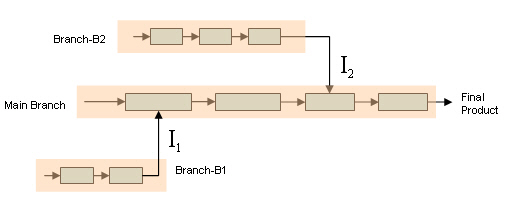
The concepts of process sections and branches exist to facilitate reporting of results for costing, economic evaluation, and resource requirements (materials, labor, power, heat transfer agents, etc.) of integrated large processes. A process section is simply a group of unit procedures that are put together with a certain goal in mind. For instance, typical sections in a process describing a biochemical plant might include the following:
1. Raw material preparation
2. Fermentation
3. Primary recovery
4. Product isolation
5. Final purification
6. Product formulation and packaging
A process branch is simply a sequence (in fixed order) of process sections that work towards a given goal. For instance, in a complicated, multi-step chemical synthesis process (quite common for synthetic pharmaceuticals and agrochemicals), you may want to distinguish between the main path and the side-synthesis paths (frequently performed by toll manufacturers).

Breaking up a Large Process in Branches & Sections.
For the purposes of this application, branches don’t serve currently any functional purpose other than dictating to the program how to report section results (branch-by- branch). By default each process is assumed to be made up of a single (‘Main’) branch and that main branch is assumed to contain a single (‘Main’) section. Even though you can add more sections to the ‘Main’ branch (and you can even rename the main branch to anything you wish) you cannot delete the branch that is designated as ‘Main’. Similarly, you can add more sections to a branch and you can rename the ‘main’ section of a branch, but you cannot delete the section designated as the ‘main’ section of a branch. All parameters related to sections and branches of a process can be accessed from the Section <SectionName> and Branch <BranchName> submenus of the flowsheet’s context menu or (as a shortcut) from buttons shown on the Sections & Branches Toolbar.